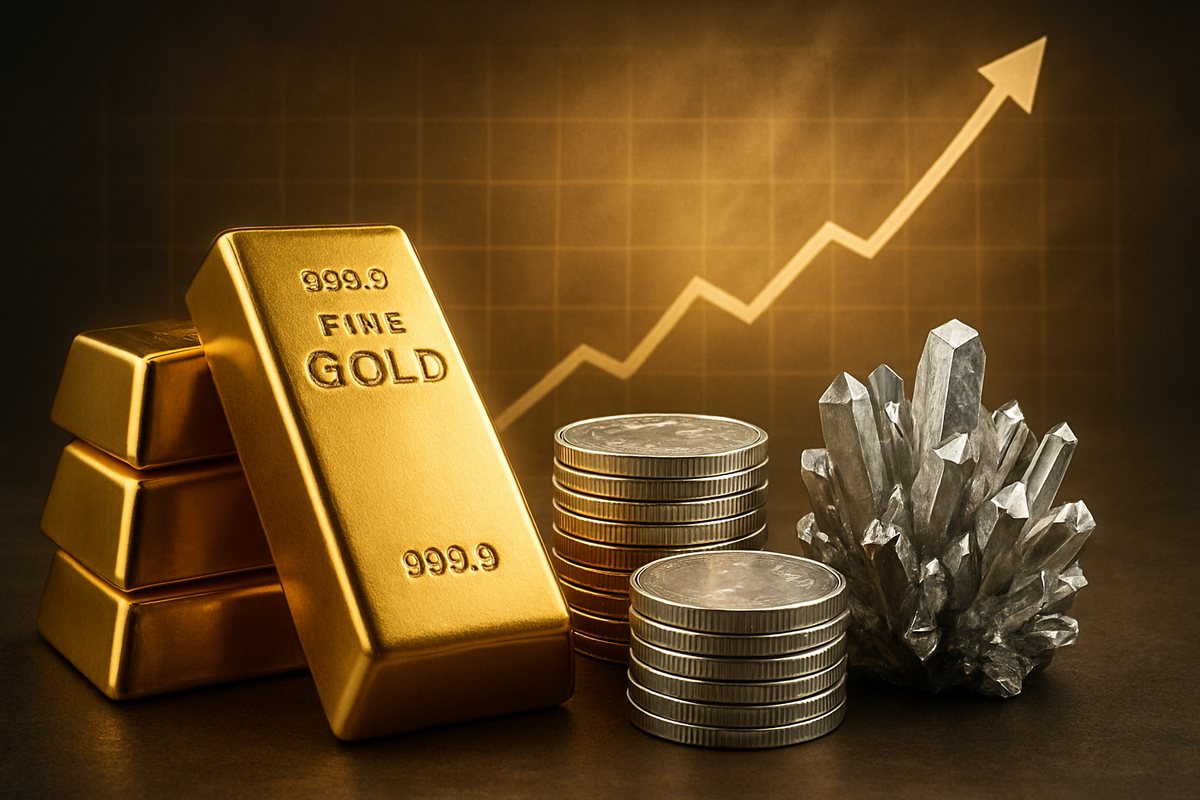
The global financial landscape is increasingly signaling a sustained upward trajectory for precious metals, with gold, silver, and platinum in particular exhibiting robust fundamentals that point towards a prolonged bull run. As of November 2025, market analysis indicates that escalating demand, fueled by a complex interplay of geopolitical instability, inflationary pressures, and burgeoning industrial applications, is consistently outstripping modest gains in global production. This structural imbalance is creating significant deficits in the physical market, pushing prices to new highs and setting the stage for continued appreciation.
Investors and central banks alike are increasingly turning to precious metals as a hedge against economic uncertainty and a store of value, while critical industrial sectors, from green energy to advanced electronics, are simultaneously driving unprecedented consumption. This dual-pronged demand surge, coupled with inherent challenges in ramping up mining output, is creating a compelling scenario for the precious metals complex, signaling a fundamental shift in market dynamics that is likely to redefine their value proposition for years to come.
The Unfolding Supply-Demand Imbalance: A Deep Dive into Market Deficits
The core of the bullish argument for precious metals lies in the widening chasm between robust demand and constrained supply. This imbalance is not a fleeting trend but a deeply entrenched structural issue affecting most of the precious metals.
Gold, often considered the ultimate safe haven, has seen its price soar, reaching around $3,500 per ounce by May 2025 and even briefly exceeding $4,300 per ounce in October 2025. While global gold supply saw a modest 1% increase in 2024 and is projected to grow by another 1% in 2025, total demand is expected to decline by 9% in 2025, primarily due to a double-digit drop in jewelry consumption as rising prices impact price-sensitive markets. However, this is largely offset by consistently high central bank purchases, estimated at around 1,000 metric tons in 2025, and strengthening investment demand, particularly from ETFs. These factors collectively ensure that overall demand continues to outpace supply, driving prices higher.
Silver presents an even more acute supply deficit. The market has faced a structural deficit for four consecutive years, with a shortfall of 148.9 million ounces (Moz) in 2024, and this is projected to persist for a fifth year in 2025, albeit narrowing to an estimated 117.6 Moz. Global silver mine production increased by a mere 0.9% to 819.7 Moz in 2024. The challenge for silver is that approximately 75% of its production comes as a byproduct of mining other metals like zinc, copper, and gold, making it difficult to ramp up quickly. New silver mines also have extensive lead times, typically 8-15 years. On the demand side, industrial consumption reached a record 680.5 Moz in 2024, a 4% increase, driven by the green economy (photovoltaic applications, electric vehicles, grid infrastructure) and AI-related electronics, and is expected to remain steady in 2025.
Platinum is also grappling with a significant structural deficit, marking its third consecutive year in 2025. The deficit was 682,000 ounces in 2024 and is projected at 539,000 ounces for 2025 by the World Platinum Investment Council (WPIC), with some forecasts even higher at 966,000 ounces. Mine supply is expected to fall by 2-6% in 2025, largely due to lower South African production, which accounts for nearly 80% of global output and is plagued by power outages and disruptions. Above-ground platinum stocks fell by 23% in 2024 and are projected to decline further by 25% in 2025, potentially depleting within three years if deficits persist. Despite an expected overall decrease in total demand for 2025, automotive demand is projected to reach an eight-year high, and investment demand remains elevated.
Palladium, while having a more nuanced outlook, also experienced a deficit of 624,000 ounces in 2024, though this was less than the previous year's shortfall. While the deficit is expected to shrink further to 120,000 ounces in 2025, with a potential surplus by 2026, mine output is still forecast to drop by 6% in 2025 due to price pressures and mine closures. This decline in primary supply will be partially offset by increased recycling from autocatalysts. The automotive sector, accounting for approximately 80% of palladium demand, is seeing softening demand due to lower production of gasoline vehicles and the rise of electric vehicles, though a "reverse substitution" from platinum could provide some support.
Companies Poised to Win and Industries Facing Challenges
A prolonged bull run in precious metals will undoubtedly create significant winners among mining companies, while potentially posing cost challenges for industries heavily reliant on these materials.
Major precious metal mining companies are set to benefit substantially from elevated prices. Barrick Gold (NYSE: GOLD), Newmont (NYSE: NEM), and Wheaton Precious Metals (NYSE: WPM) are prime examples. Higher commodity prices directly translate to increased revenue and expanded profit margins for these producers. Companies with efficient operations, low all-in sustaining costs (AISC), and healthy balance sheets will be particularly well-positioned to capitalize. This could lead to increased exploration budgets, expansion of existing mines, and potentially a wave of mergers and acquisitions as companies seek to consolidate reserves and production. For streaming and royalty companies like Wheaton Precious Metals, rising metal prices enhance the value of their existing agreements, providing significant leverage to the bull market without the direct operational risks of mining.
Conversely, industries that rely heavily on precious metals as critical components could face increased input costs. The automotive industry, which uses platinum and palladium in catalytic converters, and the electronics sector, which uses silver and gold in various components, are particularly exposed. While these industries often have mechanisms to pass on some costs to consumers, a sustained increase in precious metal prices could squeeze margins or necessitate research into alternative, cheaper materials. For instance, the ongoing shift in the automotive sector, where electric vehicles (EVs) require significantly less or no palladium/platinum compared to internal combustion engines, is partly a response to price volatility and environmental regulations. This could accelerate the search for substitutes or drive innovation in material efficiency.
Furthermore, companies involved in refining, trading, and providing financial instruments (like ETFs) tied to precious metals could also see increased activity and profitability. Investment firms offering precious metal-backed products are likely to experience higher demand from investors seeking to participate in the bull market.
Wider Significance: Economic Headwinds and Geopolitical Undercurrents
The anticipated bull run in precious metals is not an isolated event but rather a symptom and amplifier of broader economic and geopolitical trends shaping the global landscape.
Historically, precious metals, particularly gold, have served as a reliable hedge against inflation and economic instability. With central banks globally grappling with persistent inflationary pressures and the potential for slowing economic growth, the appeal of these tangible assets intensifies. The ongoing "de-dollarization" trend, where central banks diversify their reserves away from the U.S. dollar, is a significant driver of gold demand. Central bank purchases, which have been robust, are expected to remain elevated, reflecting a strategic shift in global monetary policy and a desire for greater financial autonomy.
Geopolitical tensions, including ongoing conflicts and political uncertainties in various regions, further bolster the safe-haven appeal of gold and silver. Investors seek refuge in assets perceived as immune to sovereign risks and currency fluctuations during times of global unrest. This aligns with historical precedents, where periods of heightened international instability have often correlated with strong performance in precious metals.
Regulatory and policy implications also play a role. Environmental regulations and stricter permitting processes can hinder new mine development, contributing to supply constraints. Furthermore, the increasing focus on ESG (Environmental, Social, and Governance) factors in investment decisions may favor companies with sustainable mining practices, potentially impacting capital flows within the sector. The green economy, with its demand for silver in solar panels and platinum in hydrogen fuel cells, creates a new, powerful demand driver that links precious metals directly to global sustainability initiatives.
What Comes Next: Navigating a Bullish Horizon
The outlook for precious metals suggests a dynamic period ahead, characterized by both significant opportunities and potential challenges.
In the short-term, investors should anticipate continued price volatility, but with an underlying upward bias. Geopolitical flashpoints, central bank policy announcements (particularly regarding interest rates and quantitative easing), and key economic data releases will serve as immediate catalysts for price movements. The persistent physical deficits in silver and platinum are likely to keep upward pressure on prices, potentially leading to sharp rallies as available above-ground stocks dwindle. For gold, any signs of escalating inflation or further economic deceleration could trigger significant investment inflows.
Long-term, the structural supply constraints, particularly for silver and platinum where new mine development is challenging and byproduct production dominates, will likely sustain elevated prices. Technological advancements in mining, such as improved extraction techniques for lower-grade ores, could eventually alleviate some supply pressures but typically have long lead times. The increasing role of precious metals in advanced technologies and the green economy represents a durable demand driver that is unlikely to abate. This suggests potential strategic pivots for mining companies, focusing on maximizing output from existing assets and exploring new deposits in politically stable regions.
Market opportunities will emerge for investors seeking to diversify their portfolios and hedge against inflation. This could manifest in increased demand for physical metal, precious metal ETFs, and shares of well-managed mining companies. However, challenges include managing price volatility, assessing geopolitical risks, and discerning between genuine long-term trends and short-term speculative bubbles. Potential scenarios include gold reaching $5,000 per ounce or higher by 2026, silver potentially revisiting its all-time highs above $50 per ounce, and platinum continuing its ascent as industrial demand strengthens and supply remains tight.
Comprehensive Wrap-Up: A New Era for Precious Metals
In summary, the precious metals market, particularly for gold, silver, and platinum, appears to be on the cusp of, or already deep within, a prolonged bull run. The key takeaway is the fundamental imbalance where robust and diversified demand is consistently outstripping a constrained and often declining supply. This structural deficit is not merely a cyclical phenomenon but reflects deeper trends in global economics, geopolitics, and industrial innovation.
Moving forward, the market will be characterized by sustained upward price pressure, driven by central bank buying, inflation hedging, and burgeoning industrial applications in the green and tech sectors. While palladium's trajectory is more complex due to shifts in the automotive industry, the overall sentiment for the precious metals complex remains overwhelmingly bullish. Investors should closely monitor global economic indicators, geopolitical developments, and the ongoing evolution of industrial demand drivers. The dwindling above-ground stocks of silver and platinum, coupled with the long lead times for new mine production, suggest that physical tightness will remain a significant factor.
The lasting impact of this bull run could be a re-evaluation of precious metals' role in investment portfolios and global financial systems. They are increasingly seen not just as safe havens but as essential components of the future economy. What investors should watch for in the coming months are further signs of central bank activity, industrial innovation requiring more precious metals, and any significant disruptions to mining supply chains. The current environment strongly suggests that precious metals are entering a new era of prominence and value.
This content is intended for informational purposes only and is not financial advice




